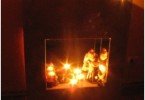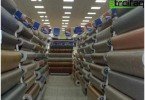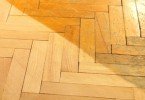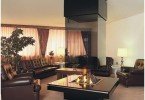Office furniture: how to choose? Read our detailed article on choosing office furniture – from chairs to the executive table. Consider the main selection criteria, as well as help determine the style of execution.
Furniture in the office is not only a necessary component of working life, but also an important component of labor efficiency and productivity. And before you buy it in a store, in the catalog by photo or make to order, read our recommendations.
Content
One way or another, but, in fact, most of our wakefulness – we spend at work. And it is critically important for each employee, whether he is an ordinary trainee or the head of a large holding, convenience and comfort in the workplace. Efficiency, productivity, fruitfulness of labor directly depends on this, but, more importantly, enthusiasm, desire and desire to do their work. After all, what kind of inspiration can come during the labor process if the employee is always uncomfortable and distracted by all sorts of little things (for example, a poorly opened desk drawer with documents)?
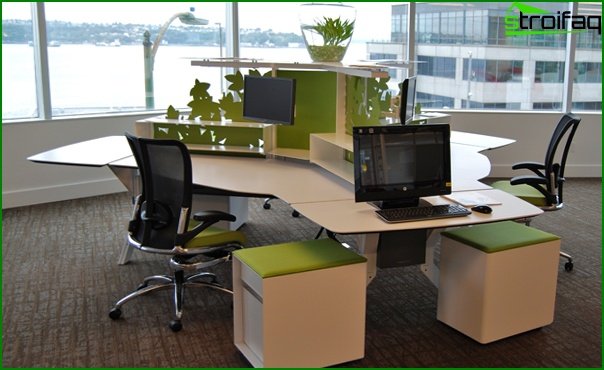
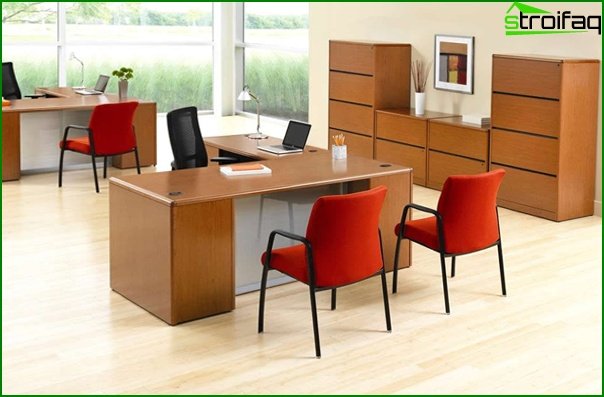
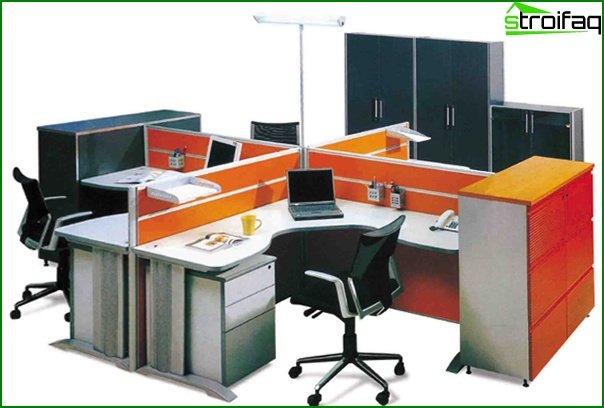
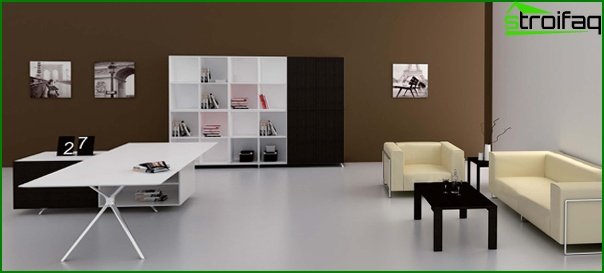
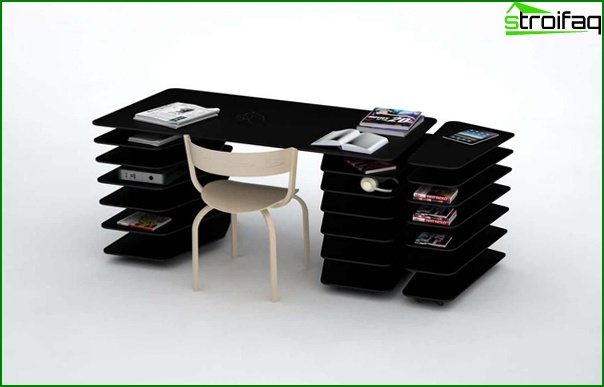
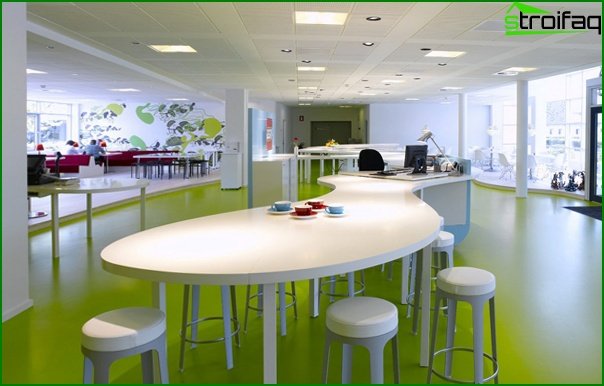
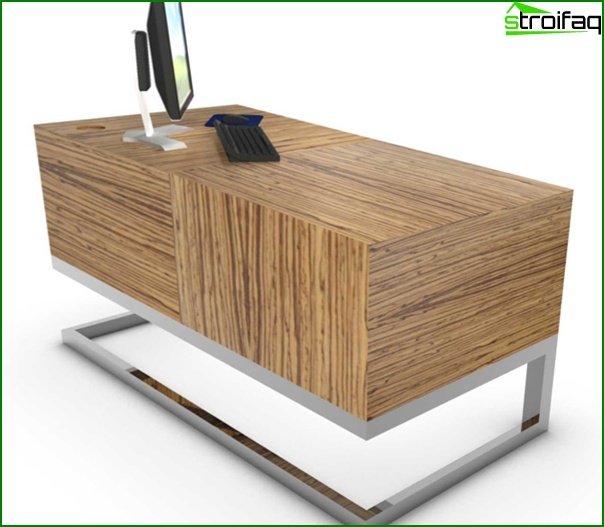
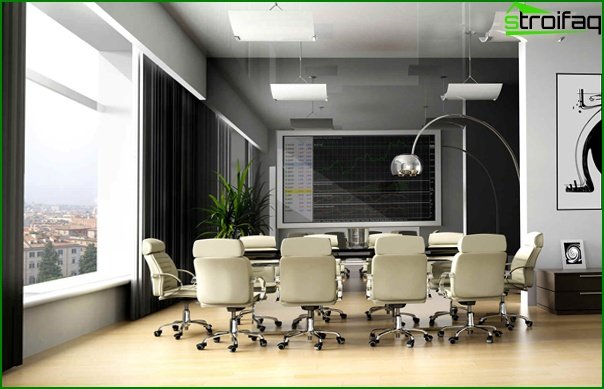
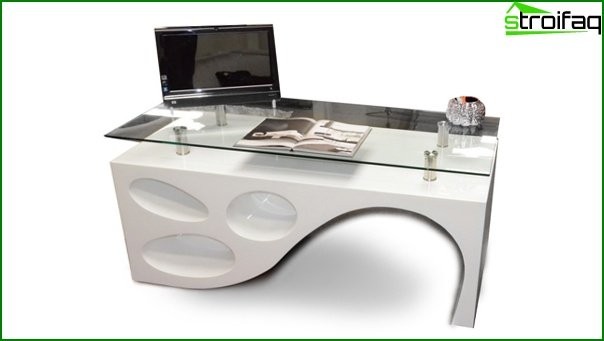
Specificity and selection criteria for office furniture
Office furniture, more than any other type of furniture, is exposed and exploited. This is due to the fact that a huge number of people happen to be in the workroom per day, and with the frequent moving of offices from place to place and with a number of various factors. That is why when buying office furniture it is necessary to focus on the following criteria:
- Strength. Since office furniture must withstand constant high loads, it must be very durable. Therefore, it is desirable that the materials of which it is made are certified.
- Reliable hardware. Frequent operation of office furniture leads to the fact that the furniture quickly breaks down and stops working. From this, even branded mahogany office furniture can become unusable in a matter of time and significantly complicate the work process..
- Ergonomics In many respects, this criterion directly depends on the planning and placement of office furniture. But even if computer desks are located at a considerable distance from each other, it will be impossible to work behind them, if, for example, they are more suitable for a school student or a miniature girl than for an adult two-meter man. Ergonomic furniture will allow employees to get less tired and, therefore, work more productively.
- Environmental friendliness. In order not to harm the health of your company employees, when choosing office furniture in the photo catalog, make sure that all the materials from which it is made are certified and have no harmful additives, treatments, etc. To protect yourself once again, try to choose products only from trusted manufacturers, for example, Ikea.
- Simplicity. The workplace should not be distracting, it should be set up as quickly as possible (except when you have a very creative profession), therefore it is better to choose furniture not intricate, but modest and unobtrusive.
Before purchasing office furniture, be sure to calculate how many employees need jobs and add at least one or two places to accommodate possible interns or trainees. After that, you need to create a detailed plan for the placement of furniture and, if the footage of the office is not enough, consider alternative options for office breading. It can be combined tables or corner, double-sided or tiny single.
These criteria are basic and must be taken into account when choosing furniture in the office of any purpose. But there are also a number of specific requirements for each individual functional office space..
Furniture for a guide
In many modern foreign films about office life, one can meet the tendency of the manager to “not separate” from his subordinates. This is a very democratic and, perhaps, even an effective company management strategy, but not typical of most firms and companies in the post-Soviet space.
In our country and in neighboring countries, the head (at least a business structure, at least a public school), as a rule, has his own office. And this office often becomes the “face” of the entire office and in many respects influences the first impression that is formed about the company or institution (even before visitors get to know its head).
Therefore, the office of the head should be representative. Furniture in such an office cannot be cheap and broken. For the manufacture of furniture for the head, only high-quality materials should be used, for example:
- Natural wood instead of chipboard or MDF
- Glass instead of clear plastic
- Quality metals instead of budget counterparts.
Safes in the manager’s office are best disguised as ordinary cabinets or cabinets, so that they attract less attention.
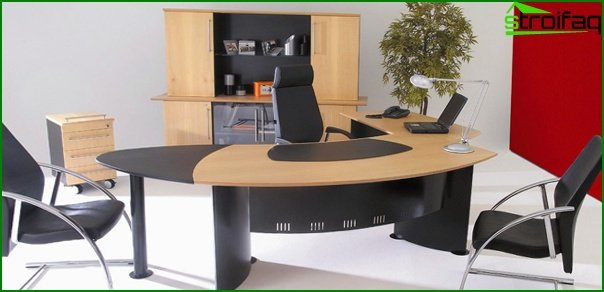
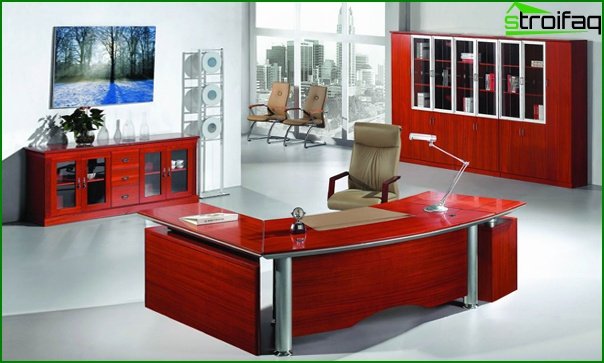
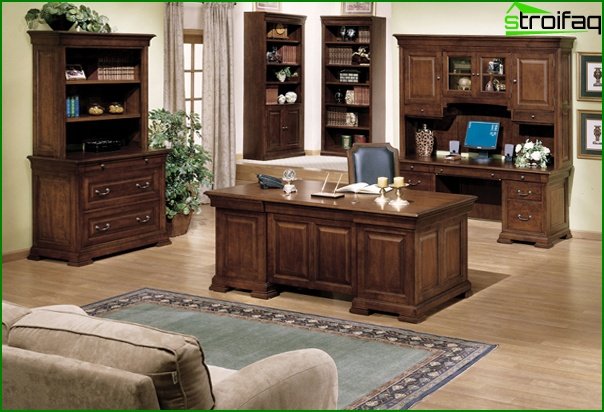
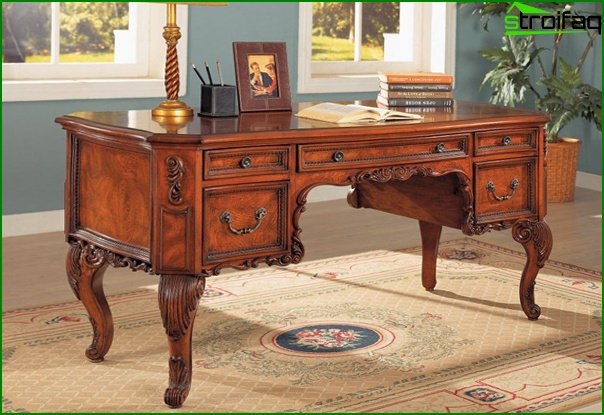
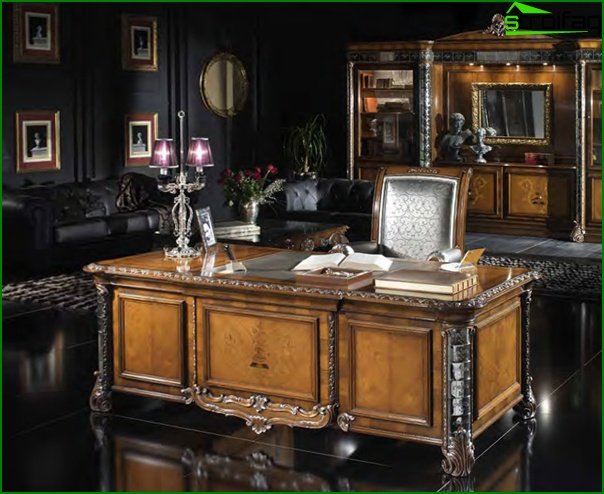
Furniture for staff
When organizing a workplace for staff, it is important to remember that each (everyone!) Employee must have at least a piece of personal space. Even if employees have one table for two, a minimum partition is needed between workstations, and drawers and cabinets should be equally divided.
Be sure to note that if there is no separate dressing room, employees will have to store their outer clothing somewhere so that it does not spoil the appearance of the office and does not create a feeling of sloppy.
If the staff works with clients, then the distance between office desks should be:
- Enough for visitors to move around the office freely.
- It’s enough that conversations and noise at the next table do not interfere with work with the client.
The desire of customers to return to it again and again will largely depend on the appearance of your office.
Materials for the manufacture of furniture may not be very expensive, but must be of high quality.
If your office is mostly not rich visitors, then too expensive and elaborate furniture will make them feel uncomfortable..
If you need furniture for staff who do not work directly with customers (for example, a security room), then you can not bother with the image component of the appearance of the furniture, but focus on its functionality and practicality.
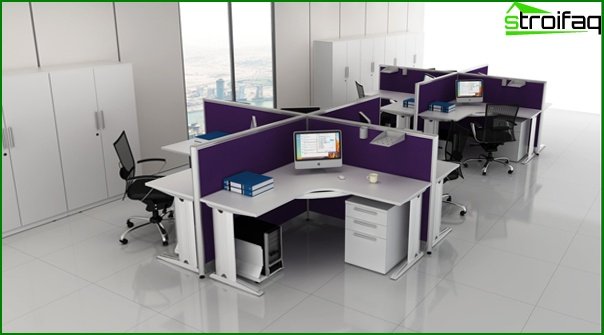
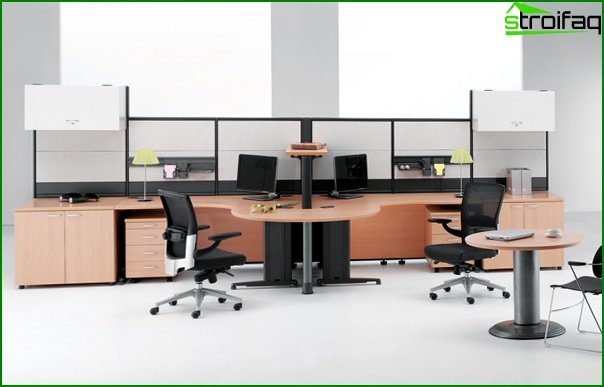
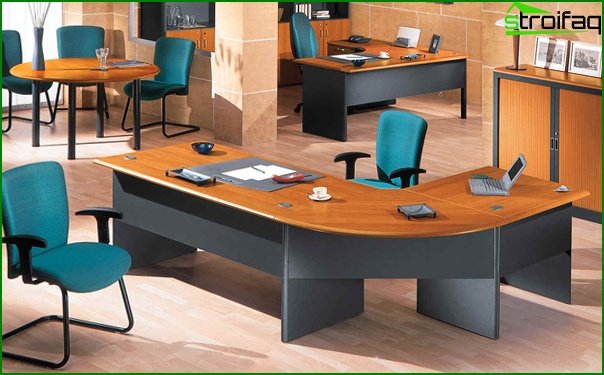
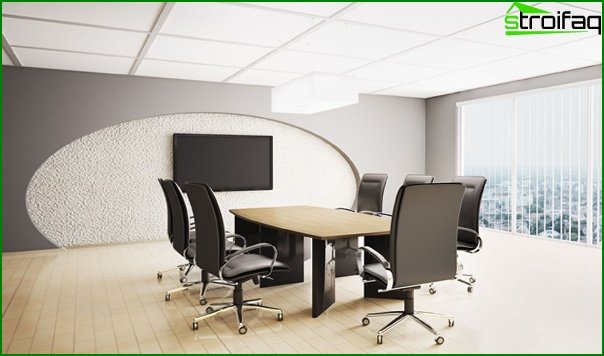
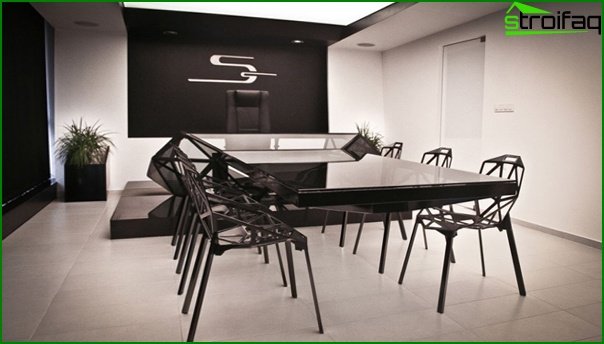
Furniture for the reception
The place where your visitors will be waiting for the reception is very important. Experts recommend placing office chairs or office sofas in the reception. You may also need a small coffee table so that it is convenient to put something on it while waiting or, if necessary, to record any information on it. It will be appropriate to place in the reception mirror, as well as a small wall-mounted TV.
Meeting room furniture
Furniture for the meeting room should be convenient and comfortable. At the same time, it is desirable to avoid details and pretentiousness – this can distract and scatter attention.
When you design a meeting room, you can use some psychological tricks. For example, if it is important to create an atmosphere of trust, use furniture in light shades, and if you need to put pressure on your partners, dark ones. Low and soft chairs, in which a person “falls through” and takes an uncomfortable posture, make him feel less confident. And vice versa – rigid high chairs, from which a person can easily and naturally stand up at any moment – give visitors self-confidence.
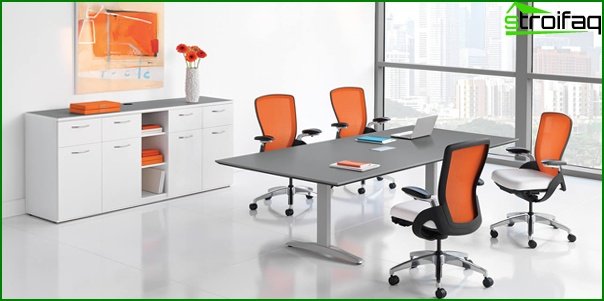

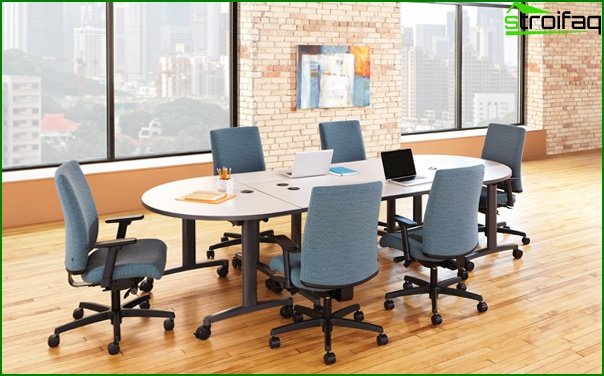
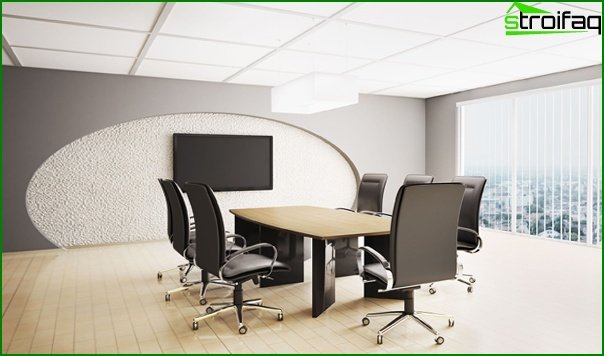
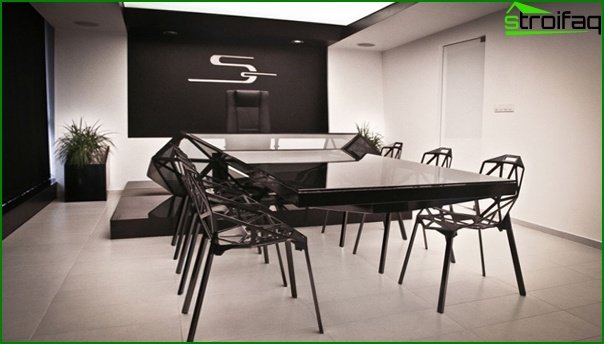
About choosing tables
Executive table
The head table should be wide enough and spacious so that, if necessary, two or three visitors or an employee can sit next to it.
So that the manager’s desk is not cluttered, but everything you need is at hand, there must be a sufficient number of drawers.
If negotiations and meetings are held directly in the manager’s office, a spacious meeting table should be placed on the table..
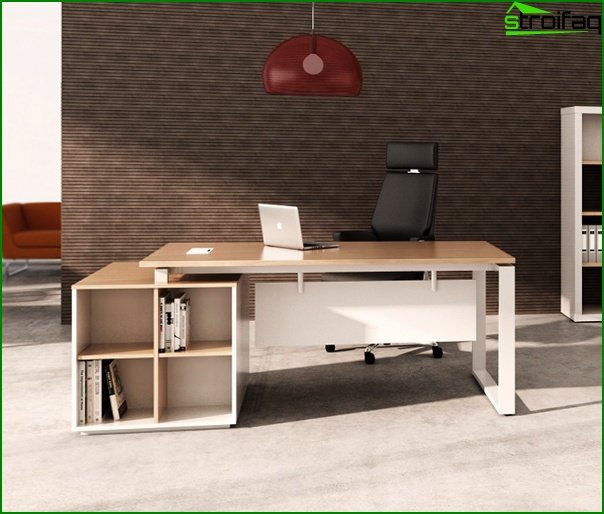
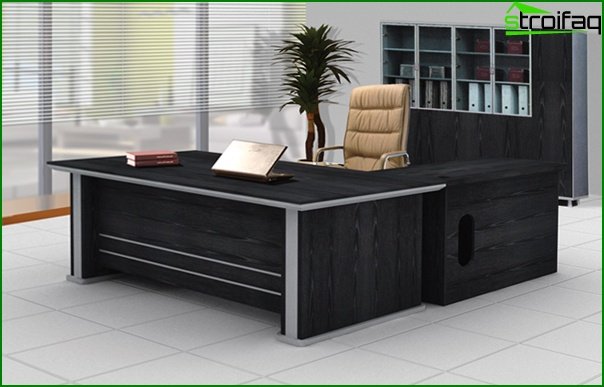
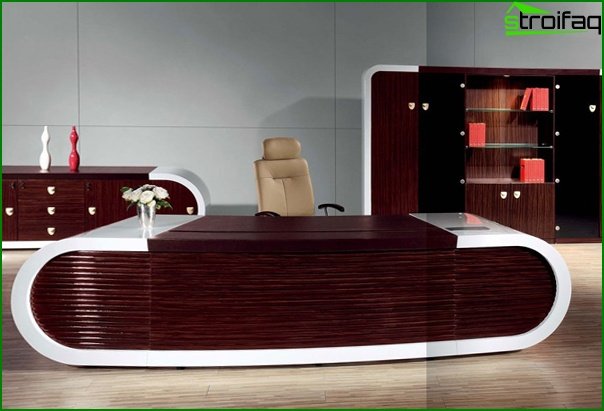
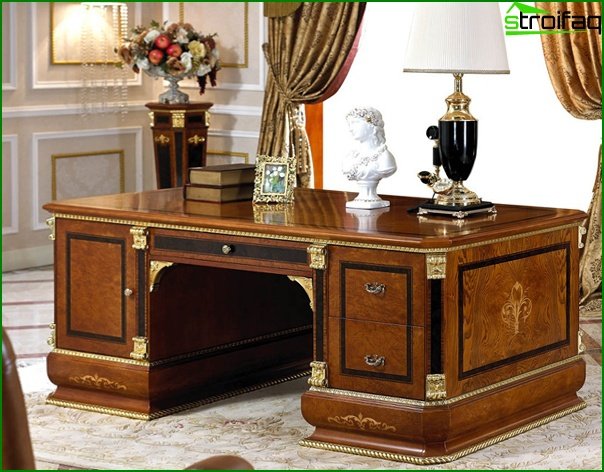
Employee desk
The employee’s desk depends on what kind of work the employee does. If most of the time he spends at a computer, then it is better to give preference to special computer tables. If an employee works with drawings – get tables with wide countertops.
The table must be equipped with drawers or a bedside table so that everything you need is at hand, but it is not put on public display.
In an office where there is not enough space, you can equip a so-called workstation: combined several desktops into one system. At the same time, each employee has his own workplace, but in general, the space is spent very economically.
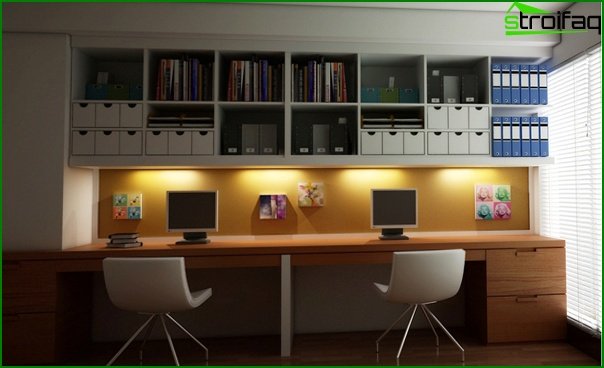
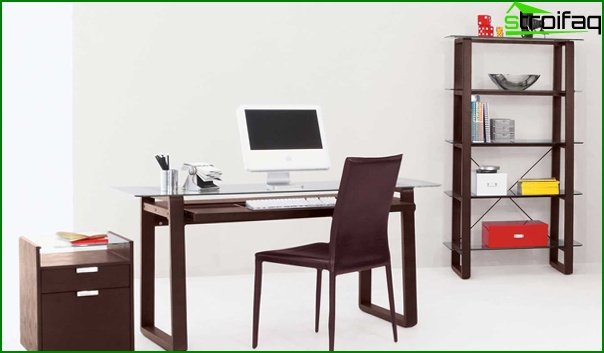
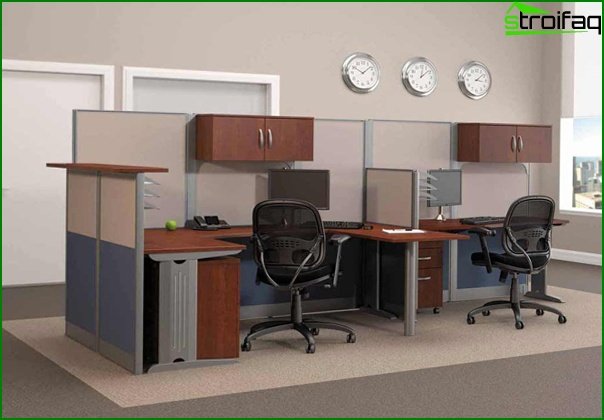
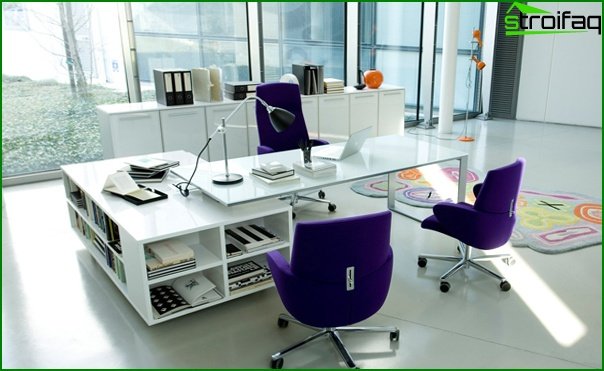

Meeting / Meeting Table
A conference or meeting table should correspond to the number of people who will most often be behind it, plus three to four spare places. In case a large number of people suddenly gather, you can use additional chairs.
The negotiation table does not imply the presence of boxes or cabinets for storing anything, such tables are as open as possible. The maximum is a small shelf under the tabletop so that visitors or employees during meetings can put some small things there.
The oval or round table allows you to more flexibly vary the number of seats for him.
To avoid embarrassment, it’s better not to use transparent glass worktops, otherwise negotiations can turn into looking at each other’s legs (which are much more difficult to control than a person or hands).
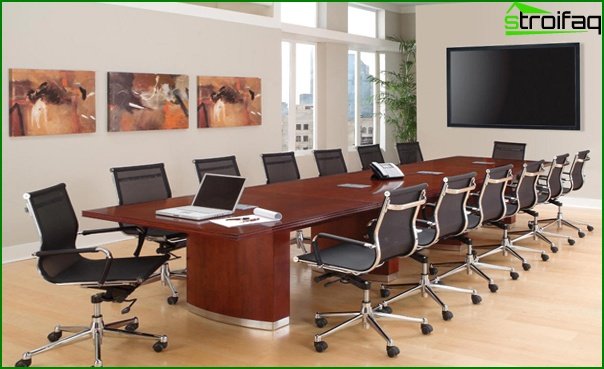
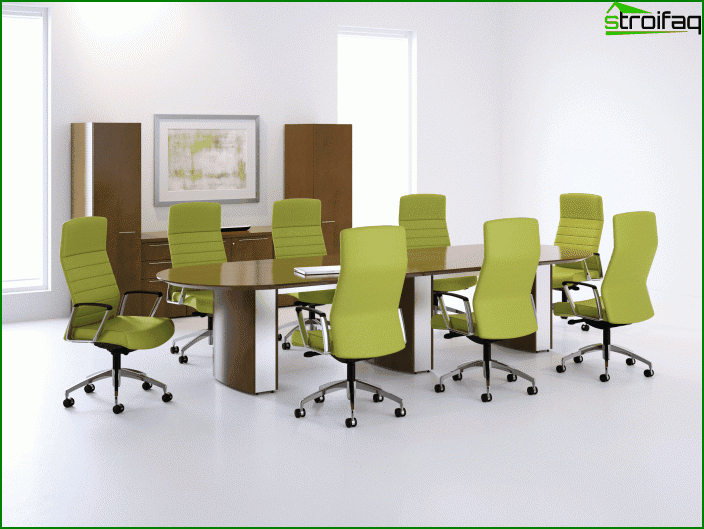
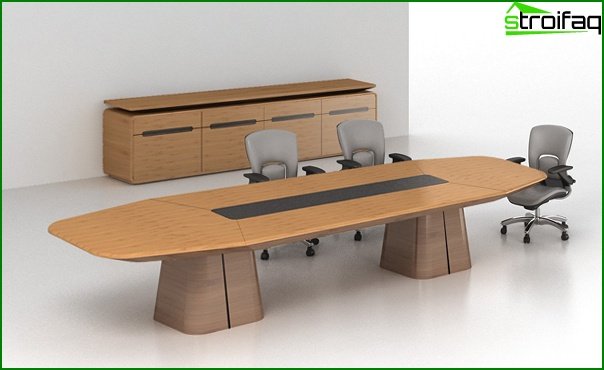
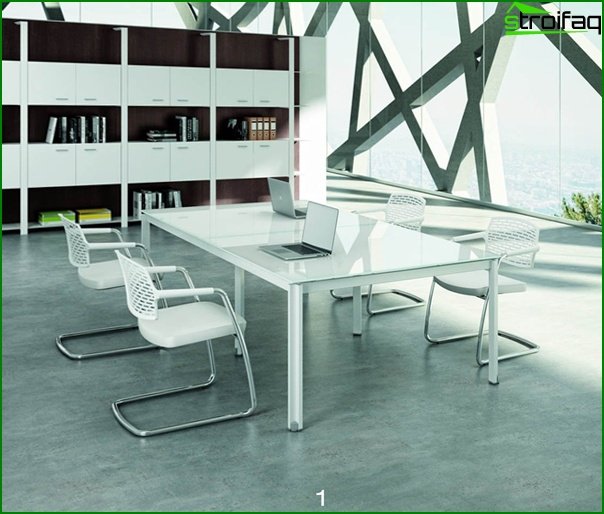
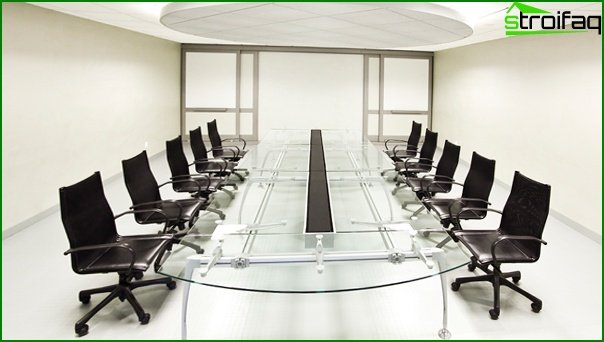
About the choice of seats
Office chairs
Office chairs are the most budgetary, but the least comfortable option for office workers, so it will be inconvenient to sit behind them for so long. They can be purchased for employees who spend less of their time at the table or for customers (if their visits are short-term).
A wide variety of office chairs assortment allows you to create unusual and interesting office interiors.
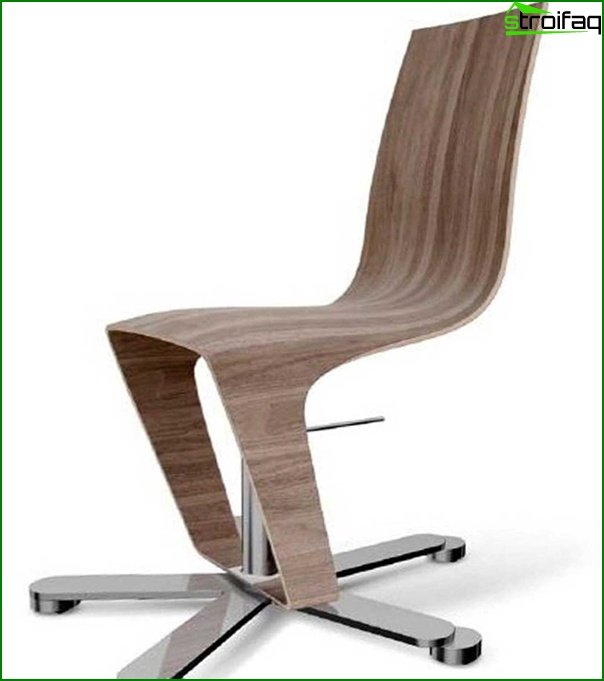
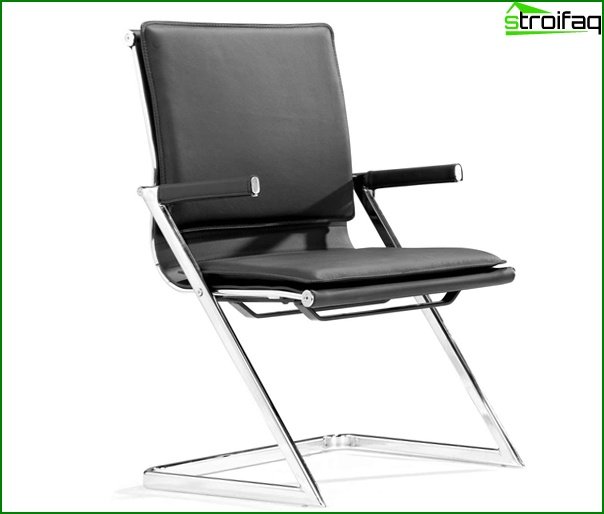
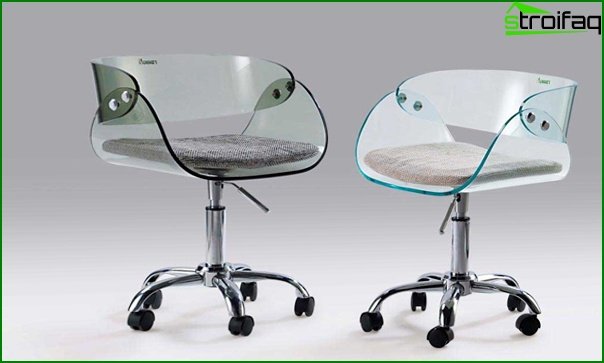
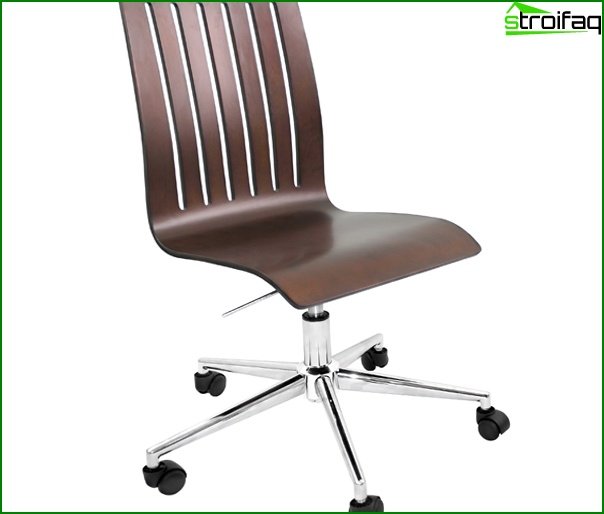
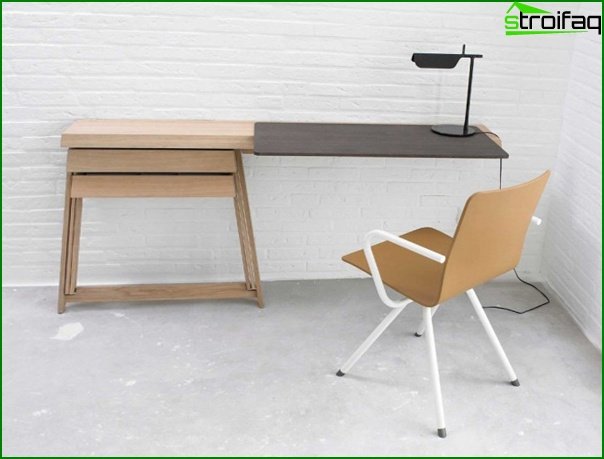
Office chairs for managers and employees
If the work is predominantly sedentary, then it is worth purchasing office chairs. To sit comfortably in an office chair, it is desirable that:
- The height of the chair was adjusted (since the growth of different employees is different)
- There were handrails (so that the hands were where to lay down during the rest)
- There was a high back (so that it was possible to change the position of the back during work)
- Wheels and a rotary mechanism (it will be very convenient if the employee often has to get something around)
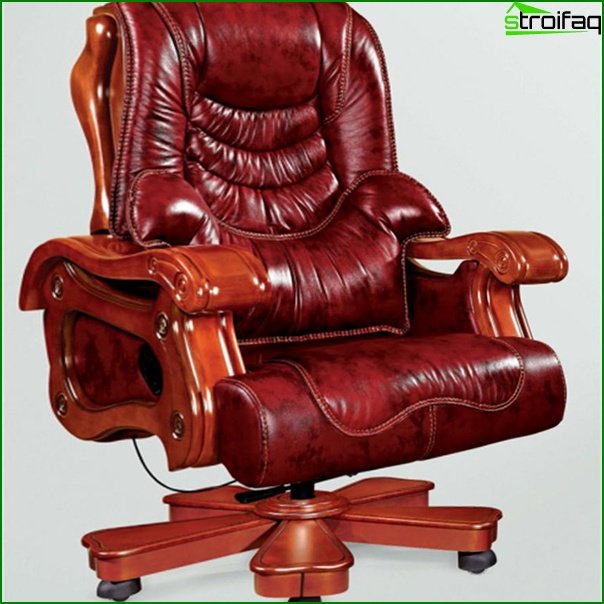
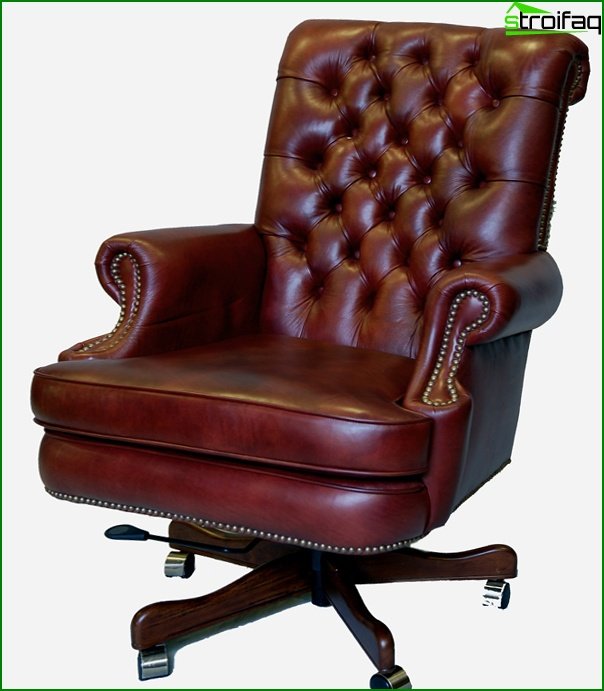
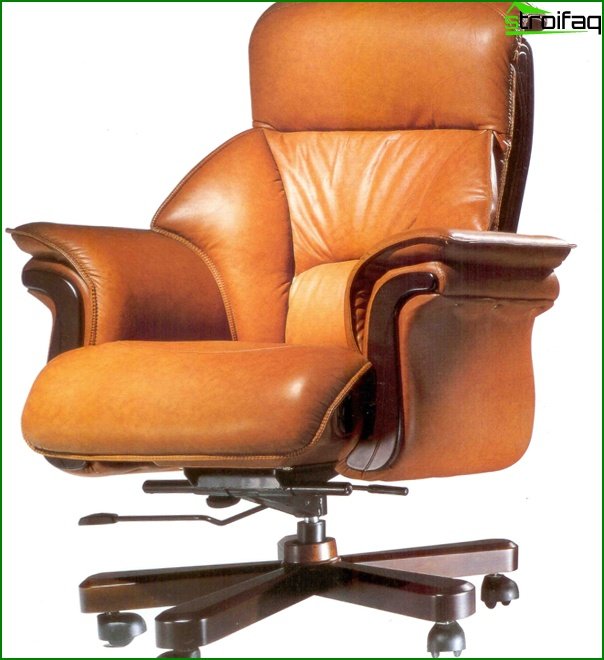
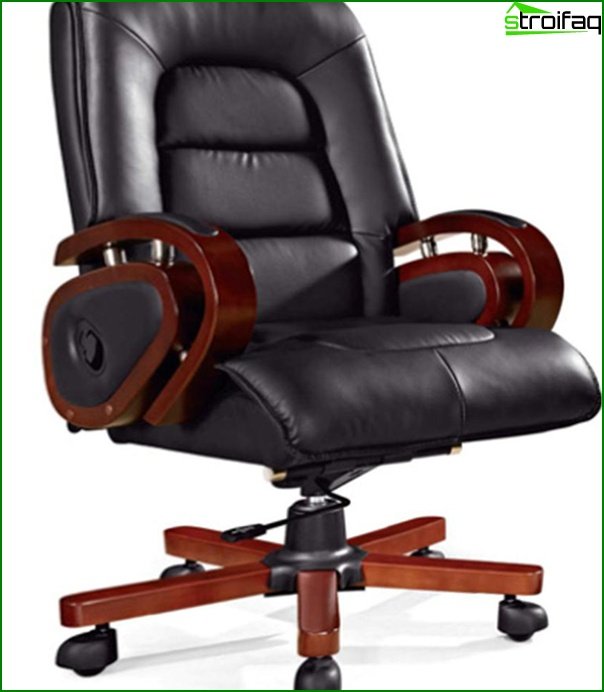
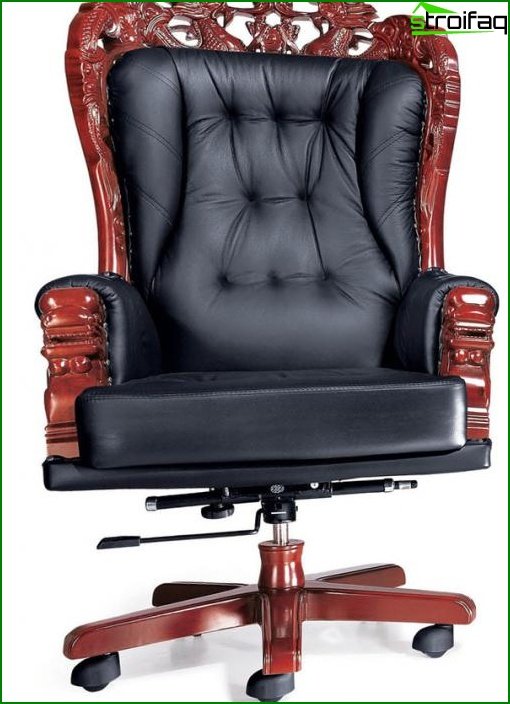
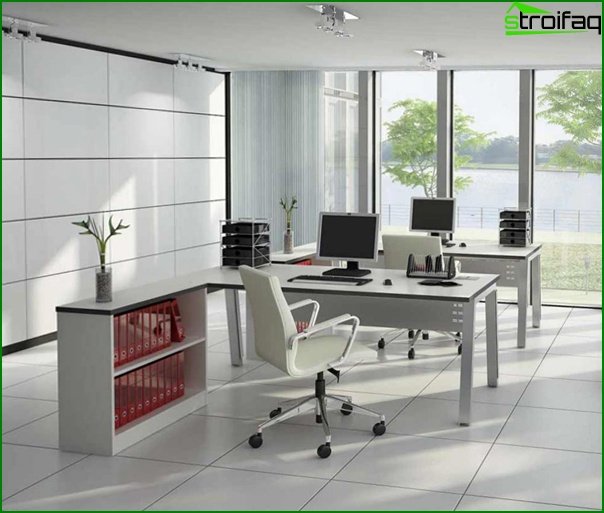
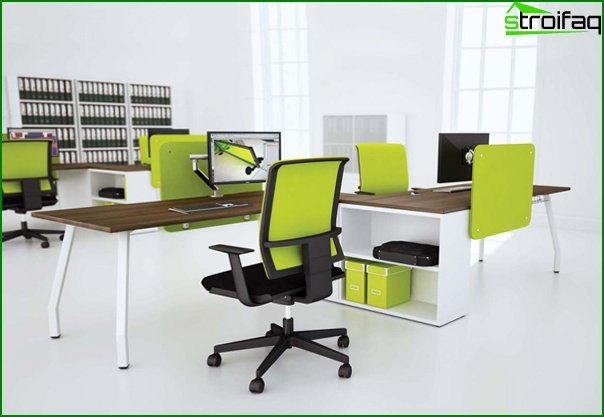
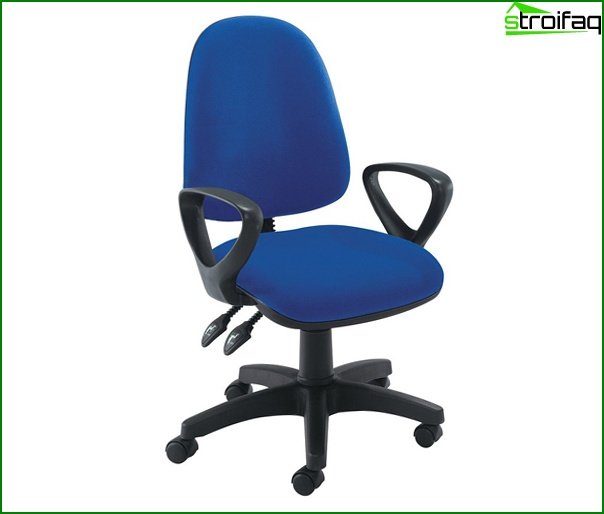
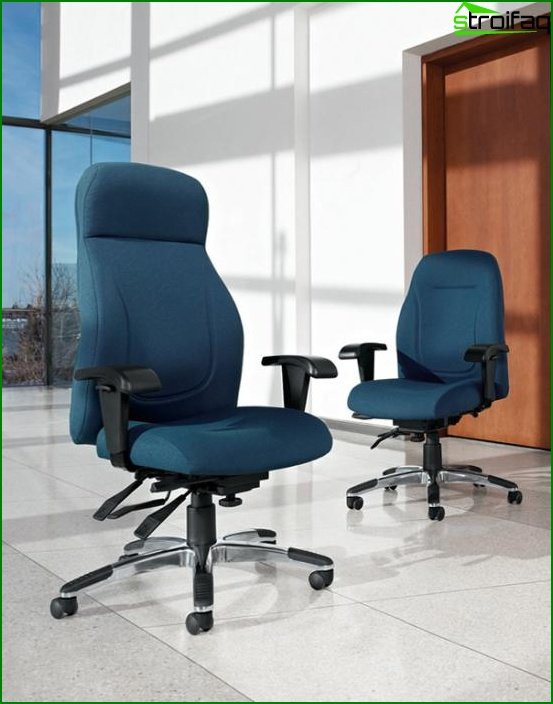
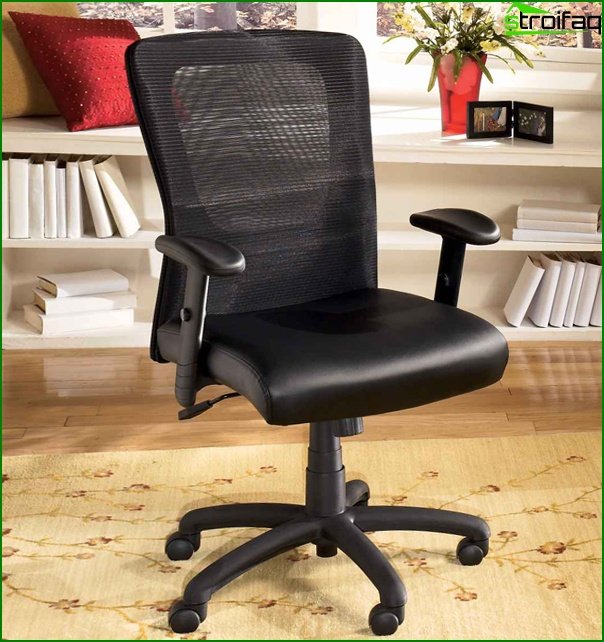
Office sofas
Office sofas are used to equip reception rooms or lounges for employees. To make the sofa serve you for a long time – choose models with genuine leather upholstery.
Related article: Cushioned furniture
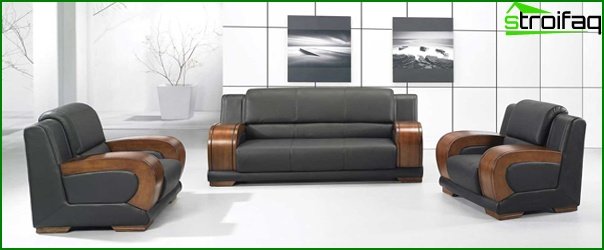
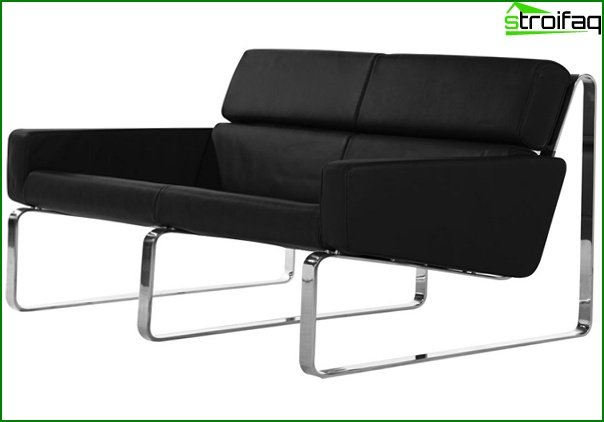
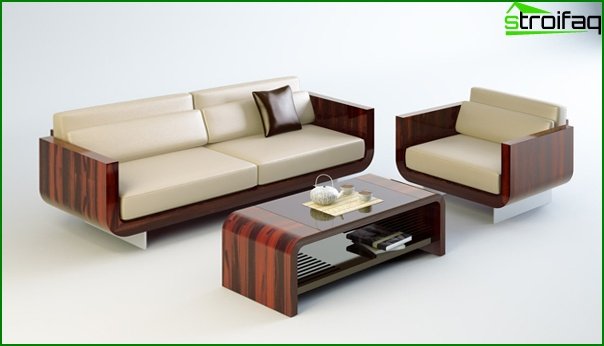
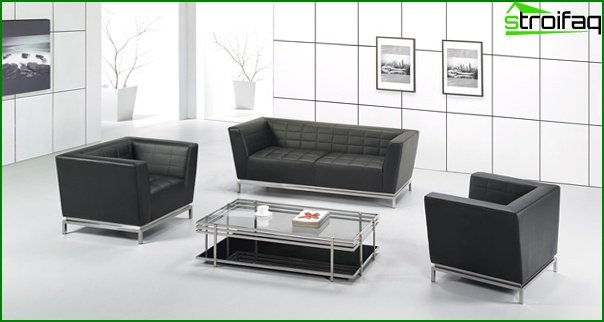
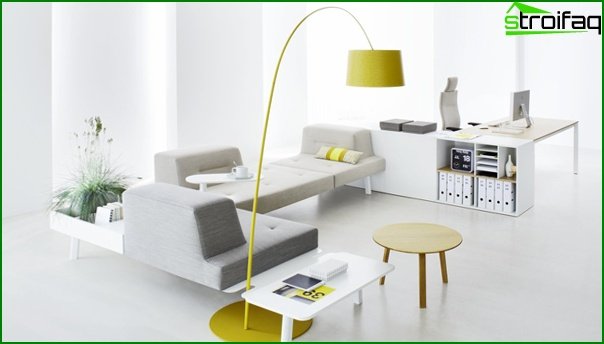
About choosing storage systems
File cabinets
By and large, file cabinets are cabinets with drawers. The depth of the boxes must be selected depending on what documents are stored in them.
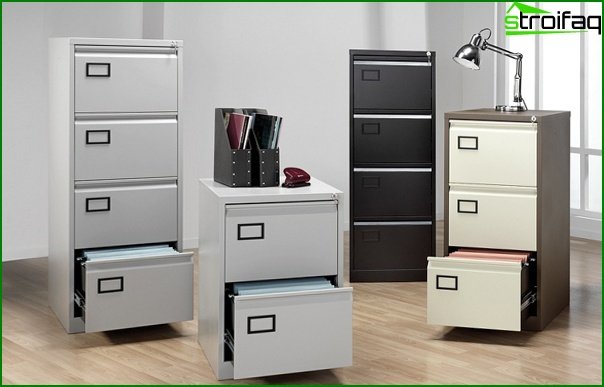
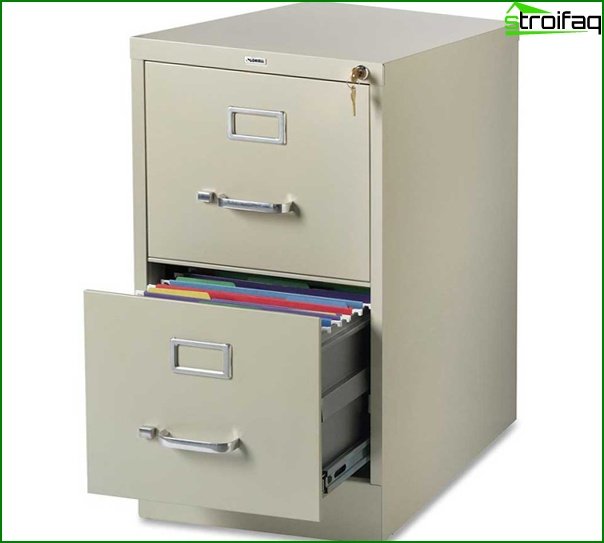

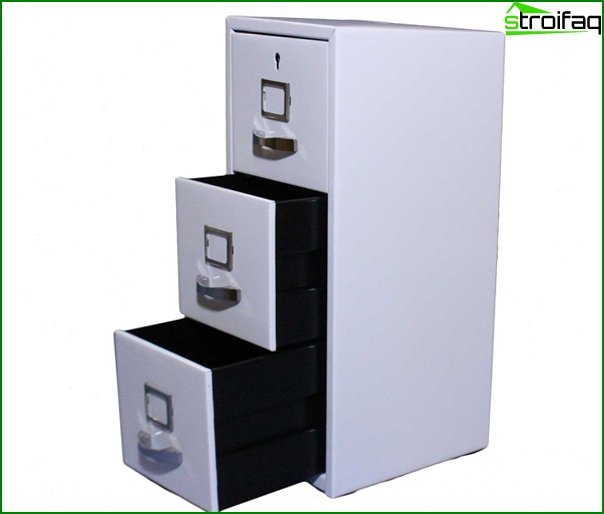
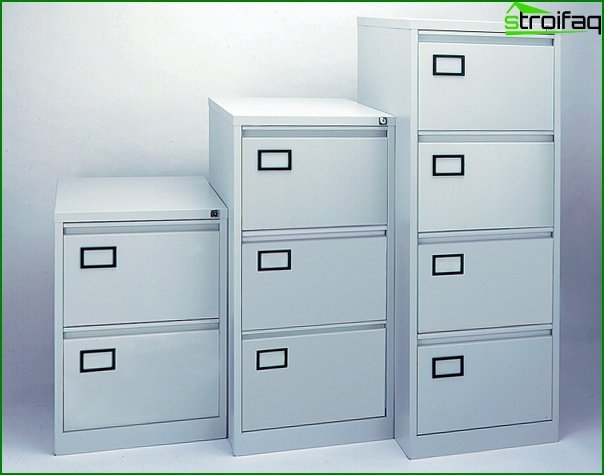
Shelving
An alternative to a file cabinet can be a rack. This is convenient if, for example, you need to get several folders with documents at once or you cannot distribute them only alphabetically, by year or by any other one principle (as in the case of a card file).
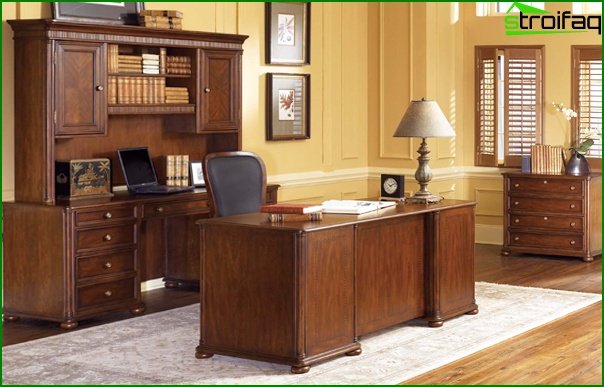

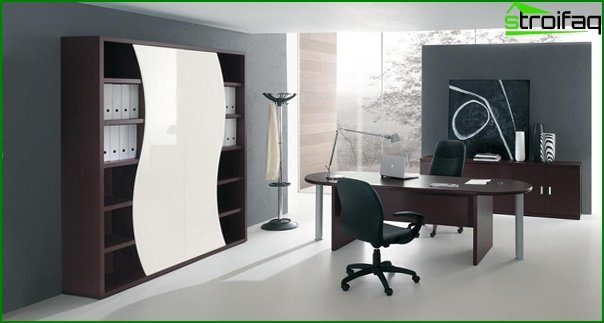
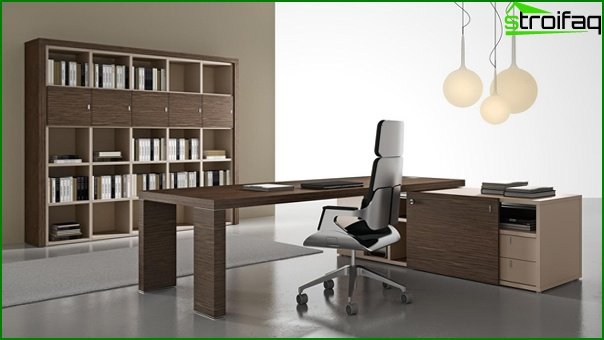
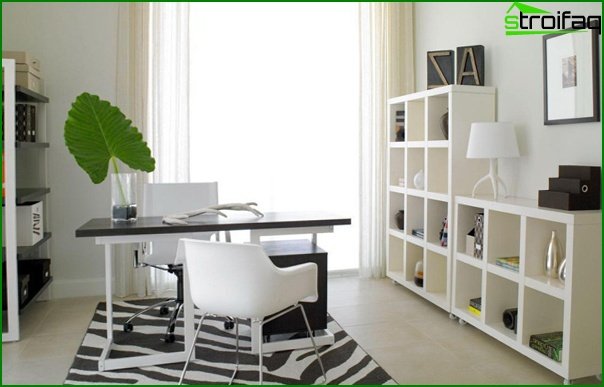
Pedestals
In small offices it is better to use built-in (for example, a table) cabinets. In larger office rooms, tubes can be used to store something bulky and not often delivered.
To order you can make a cabinet directly to the needs of your office, for example – with shallow drawers-stands for drawings.
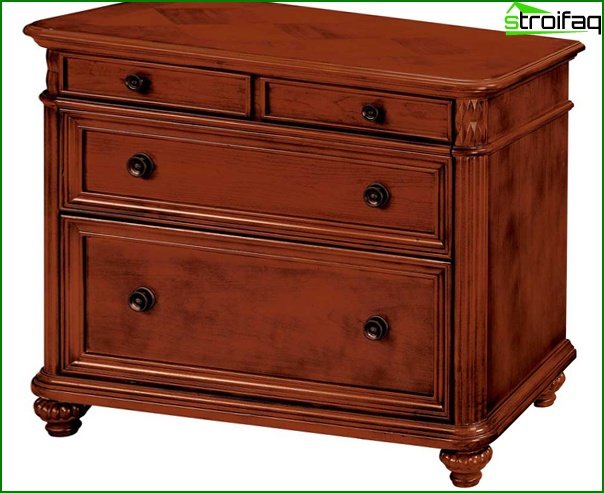
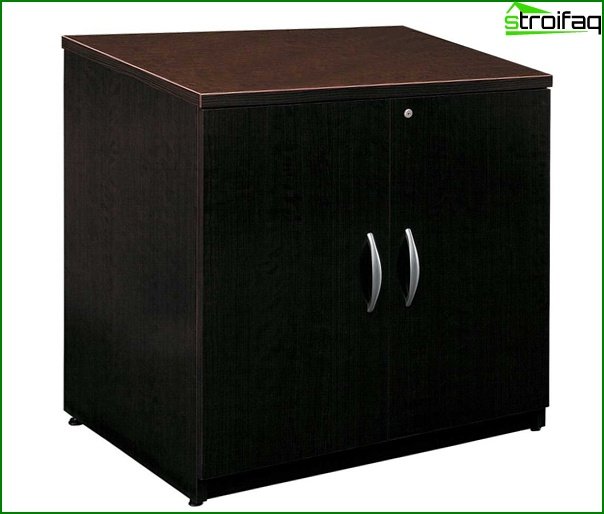
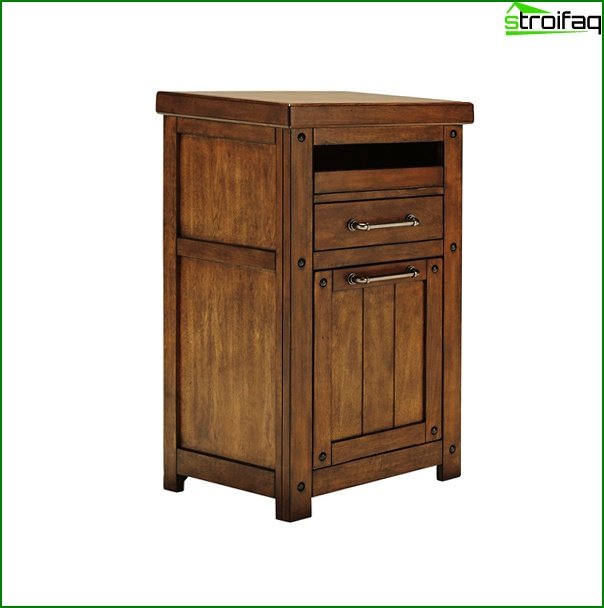
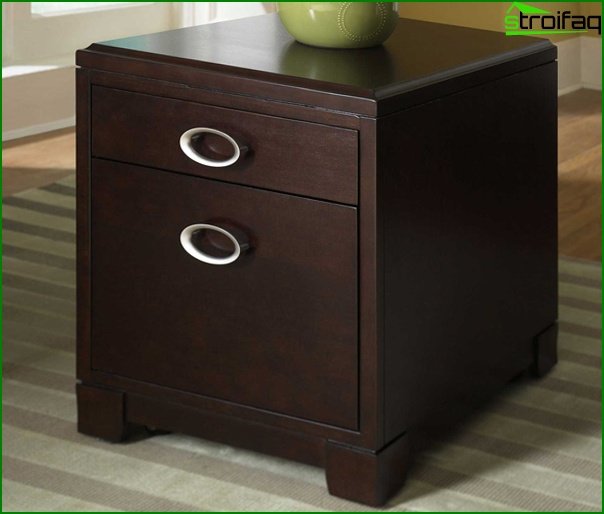
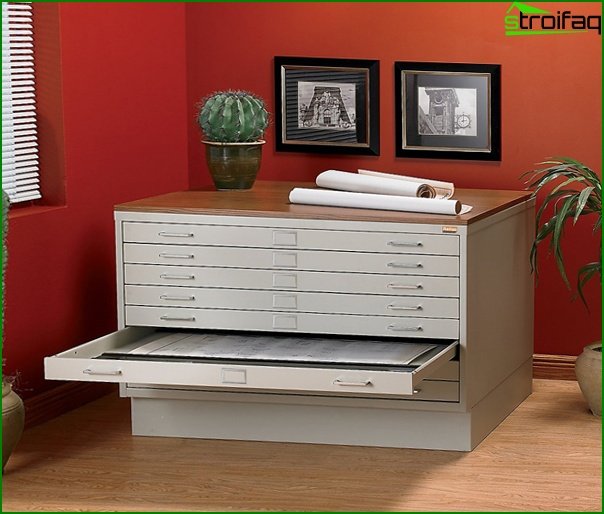
Office Style
Depending on the style of the office space, it is possible to form a different opinion with the clients about the company.
Classic
Classic style can be used to create the image of a reliable company that you can trust, which values its reputation. Perfectly fits into the interior of a bank or real estate agency.
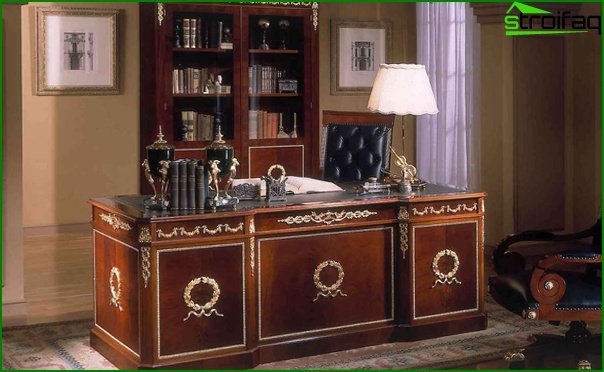
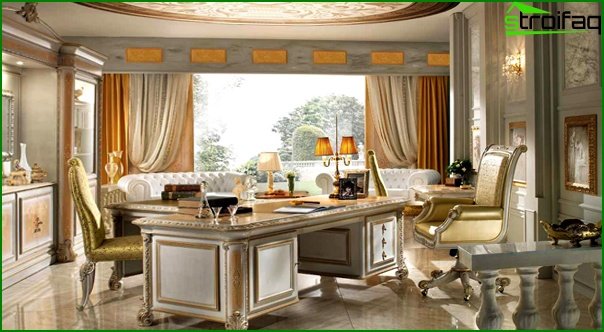
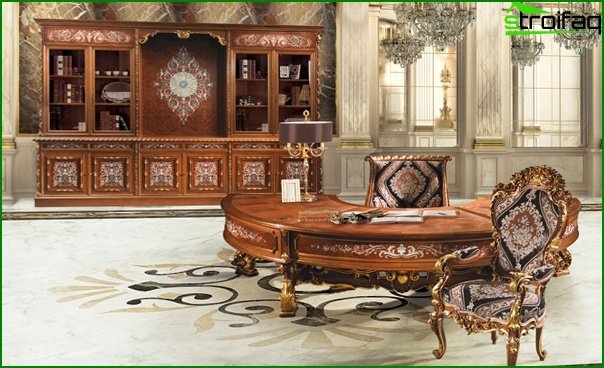
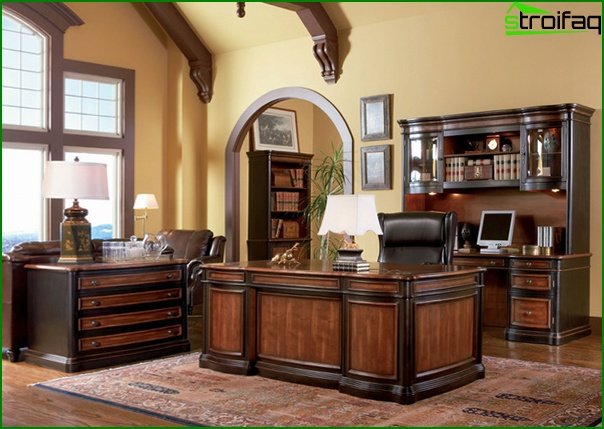
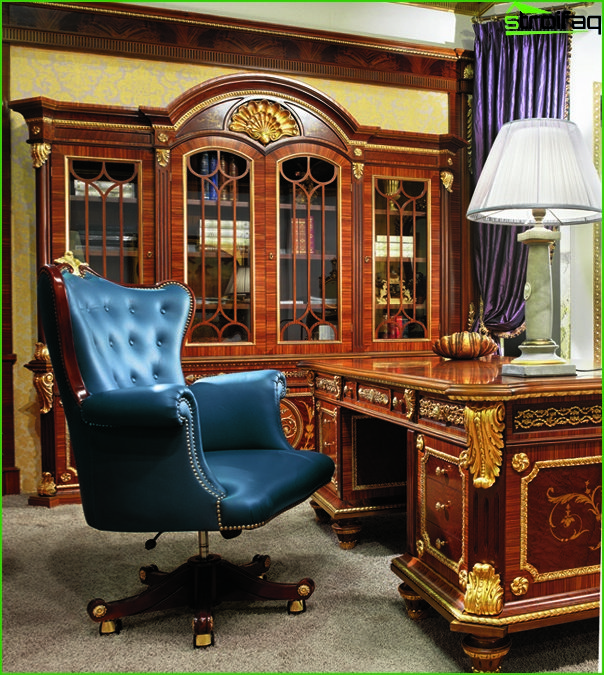
Minimalism
A minimum of details in the interior of the office will indicate your focus on results. Suitable for companies engaged in technology development or investment business.
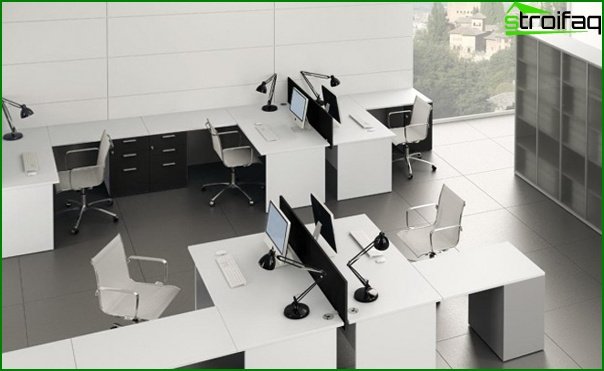
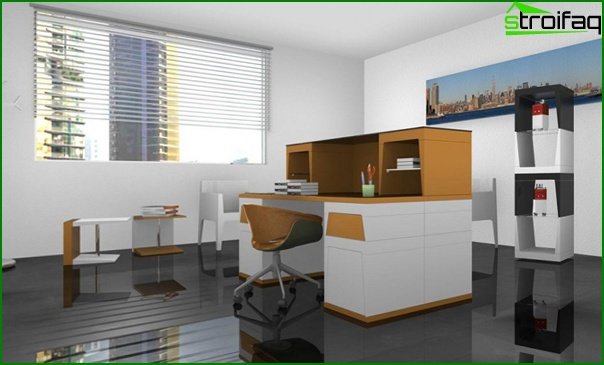
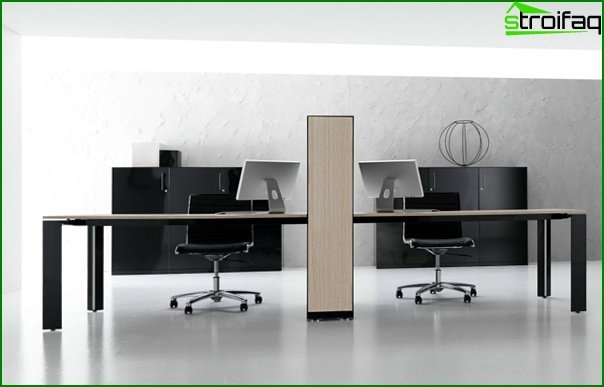
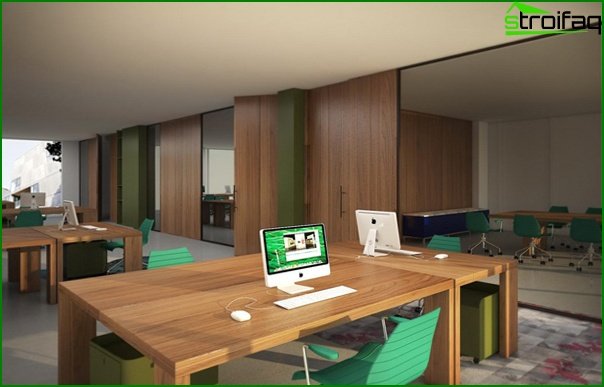
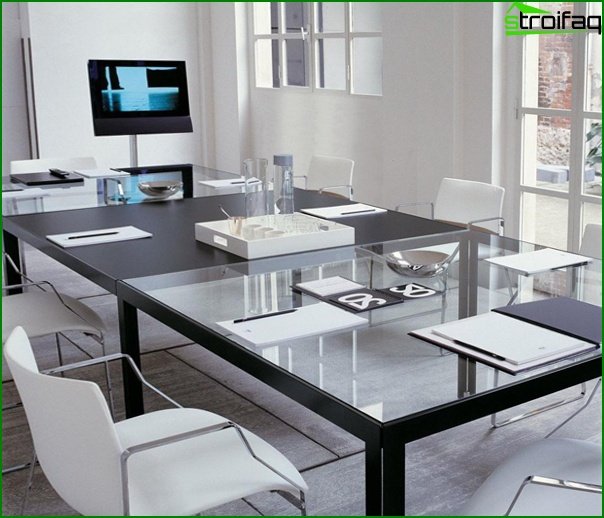
High tech
High-tech is a style for progressive, young, developing firms. This style of decoration will emphasize your desire to keep up to date. Perfectly fits into the interior of the IT technology office, home appliances, etc..
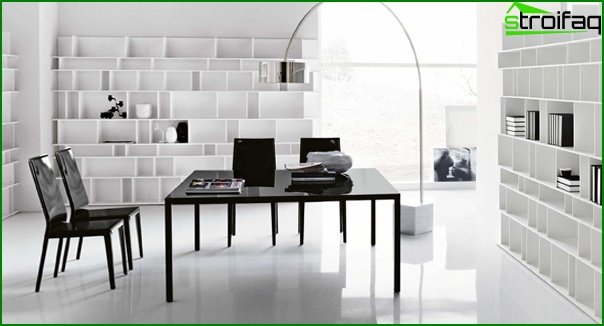
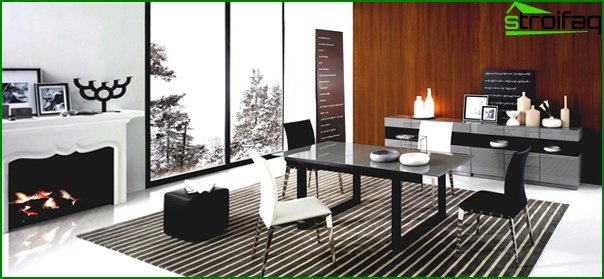
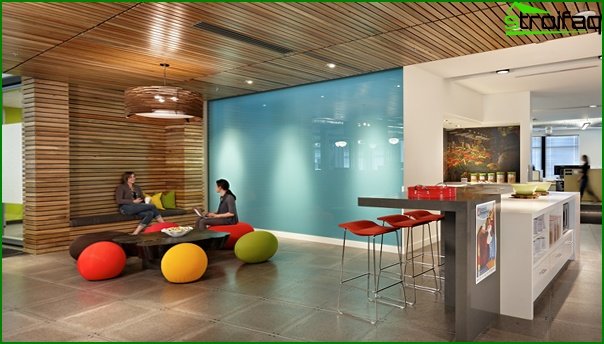
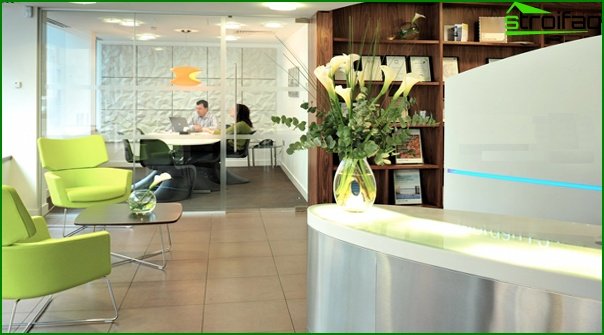
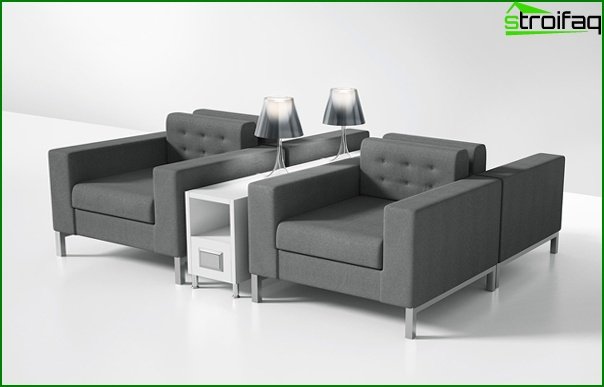
Eclecticism
Combining the incompatible is the destiny of creative natures. This style is ideal for decorating fashion atelier offices, magazine editorial offices or advertising agencies..
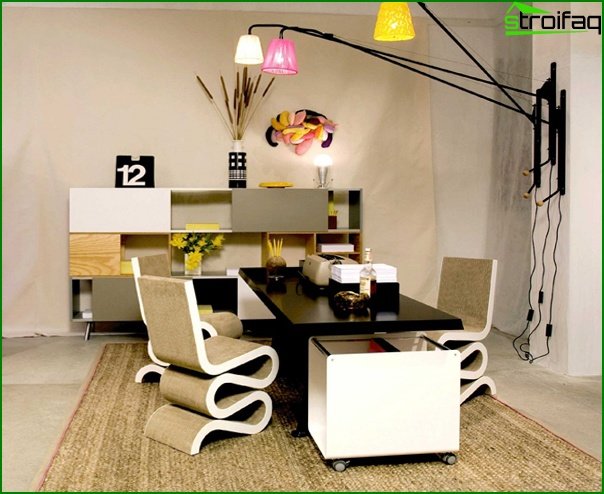
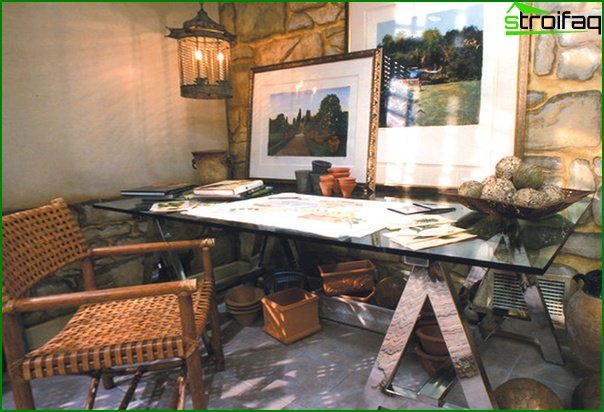
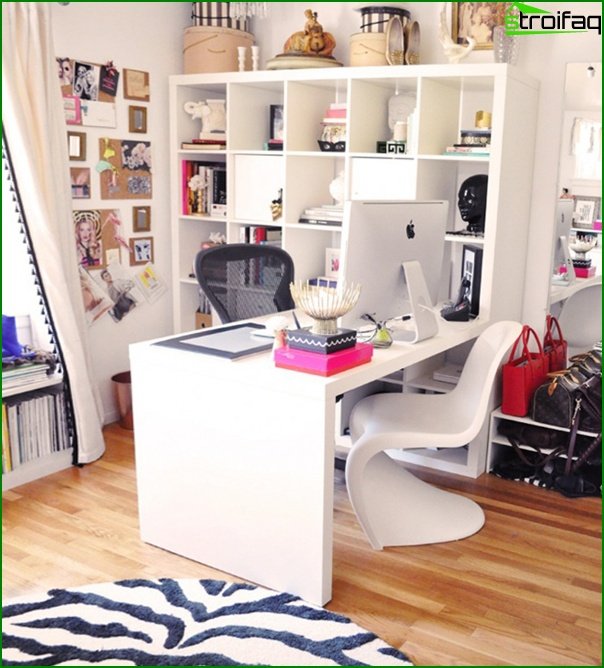
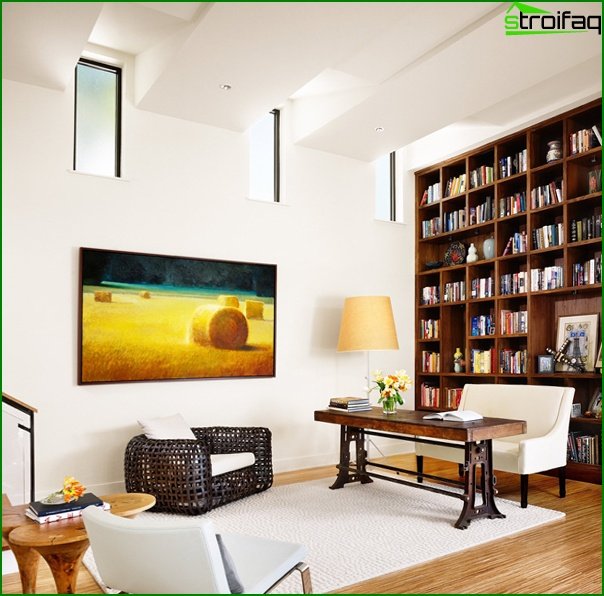
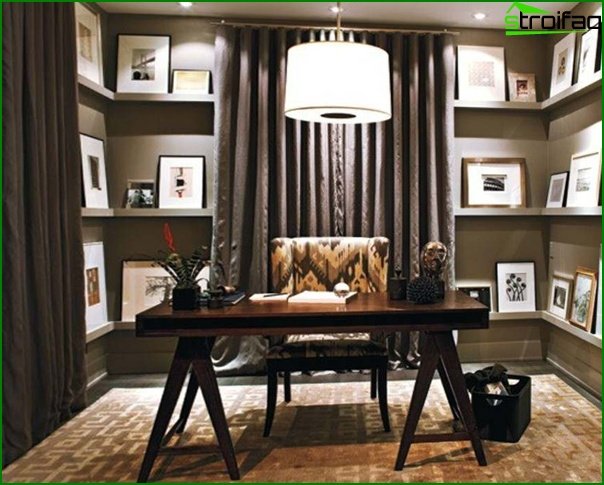
Modern
Proximity to nature – the leitmotif of the Art Nouveau style. Having designed an office in this style, you will emphasize your openness and desire to maintain harmony with the world around us. The office in modern style for a travel agency or medical center will look great.
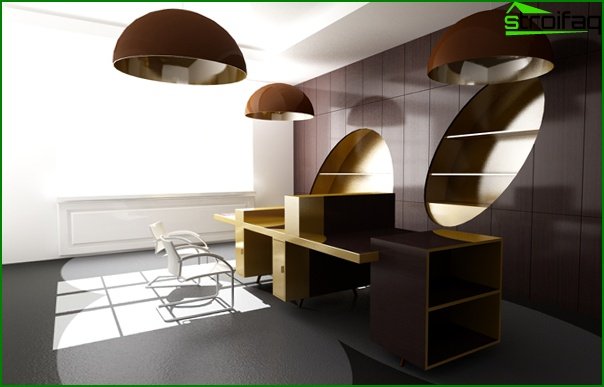
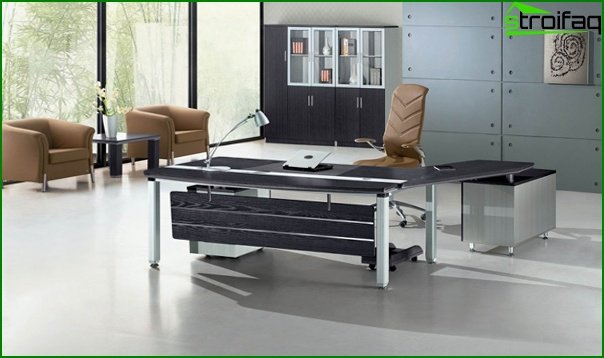
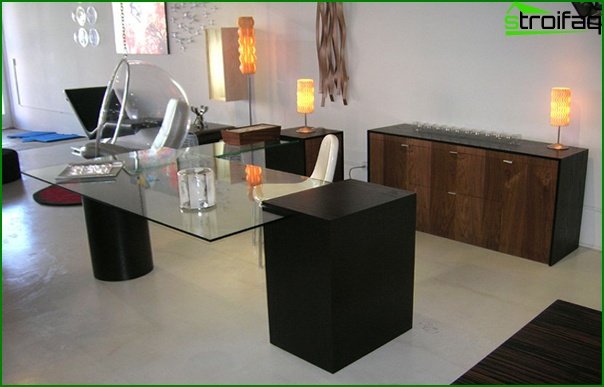
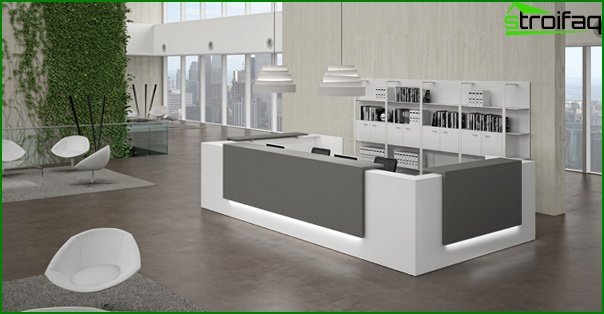
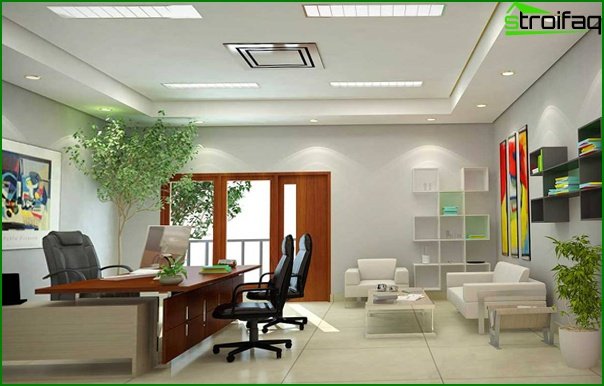
| classic | reliability confidence reputation traditional |
| minimalism | performance confidence pragmatism |
| high tech | modernity determination perspectivity development |
| eclecticism | creativity extraordinary courage |
| modern | balance moderation reliability |


